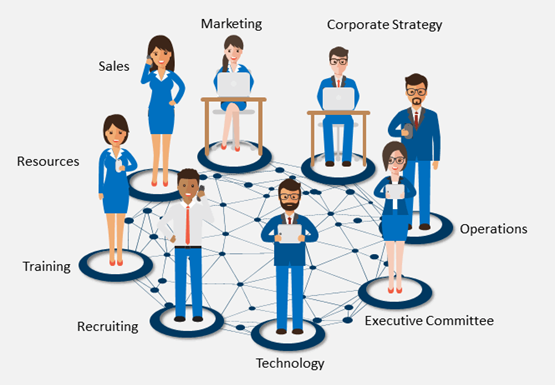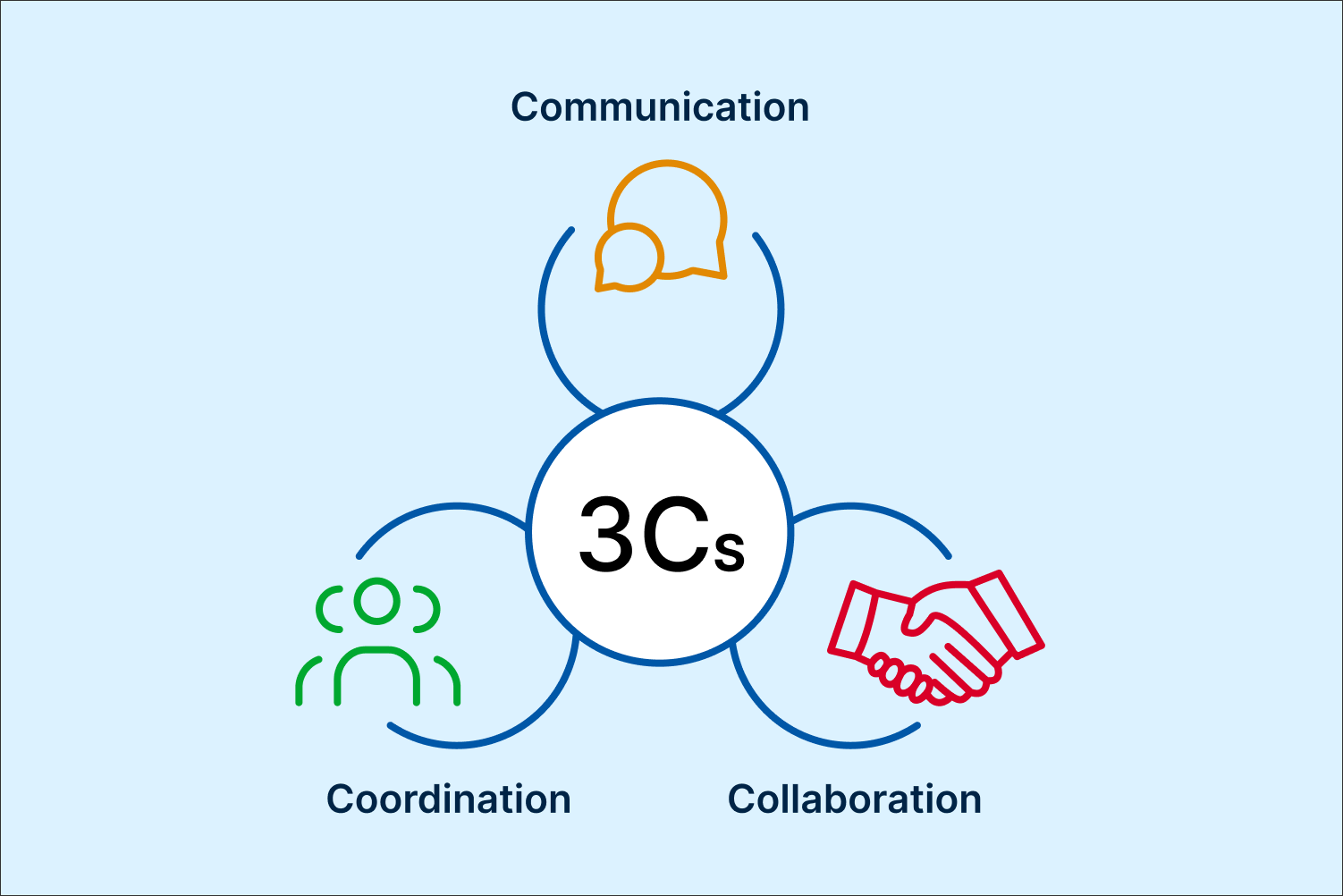Cross-Functional Collaboration Strategies: Breaking Down Organizational Silos
The Critical Need for Cross-Functional Collaboration
In today's complex and fast-paced business environment, the ability to collaborate effectively across functional boundaries has become a critical organizational capability. As markets evolve rapidly and customer demands become increasingly sophisticated, organizations can no longer afford to operate in isolated departmental silos.
Cross-functional collaboration—the process of bringing together people with different functional expertise to achieve a common goal—has emerged as a powerful approach to solving complex business challenges, driving innovation, and creating competitive advantage.
Key Insight
According to a study by Deloitte, organizations with strong collaborative practices are twice as likely to outgrow competitors and significantly more profitable than those operating in functional silos.
The Business Case for Cross-Functional Collaboration
Before diving into strategies, it's important to understand why cross-functional collaboration matters. Organizations that excel at cross-functional collaboration enjoy numerous advantages:
Enhanced Innovation
When diverse perspectives come together, new ideas emerge. Cross-functional teams combine different knowledge domains, leading to innovative solutions that might not arise within a single department.
Improved Decision Making
Decisions informed by multiple functional perspectives tend to be more robust and consider a wider range of implications, reducing the risk of unforeseen consequences.
Faster Time to Market
When departments work in parallel rather than sequentially, development cycles shorten. Early involvement of all relevant functions helps identify and address potential issues more quickly.
Enhanced Customer Experience
Cross-functional collaboration ensures that the customer perspective is considered across all aspects of product or service development, resulting in more cohesive customer experiences.

Common Barriers to Effective Collaboration
Despite its benefits, cross-functional collaboration often faces significant challenges. Understanding these barriers is the first step toward overcoming them:
Functional Silos and Territorial Behavior
When departments operate as independent units with limited interaction, they develop their own cultures, priorities, and ways of working that can be difficult to integrate with other functions.
Misaligned Incentives and Goals
When each department has its own objectives and reward systems, cross-functional initiatives may be seen as distractions from "real work" rather than valuable contributions to organizational success.
Communication Challenges
Different departments often speak their own "languages" with specialized terminology and communication styles, making cross-functional dialogue difficult without deliberate translation efforts.
Lack of Collaborative Leadership
Without leaders who model and champion collaborative behavior, cross-functional initiatives often lack the support and priority needed to succeed against competing demands.
Insufficient Collaborative Infrastructure
Many organizations lack the systems, tools, and spaces—both physical and digital—that facilitate effective cross-functional work and information sharing.
Key Strategies for Effective Cross-Functional Collaboration
Successfully breaking down silos and fostering meaningful cross-functional collaboration requires deliberate strategy and sustained effort. Here are proven approaches that can transform how your organization collaborates:
1. Establish Clear Shared Purpose and Goals
Effective cross-functional teams need a compelling "why" that transcends departmental boundaries. Shared purpose creates the foundation for collaboration.
- Define objectives that require multiple functional contributions to achieve
- Express goals in customer-centric or organization-wide terms rather than functional language
- Ensure all team members understand how their expertise contributes to the shared goal
- Regularly revisit and reinforce the shared purpose to maintain alignment
Implementation Example:
A financial services company forming a cross-functional team to improve their digital customer experience might frame their shared purpose as: "To create a seamless digital journey that delights our customers and strengthens their financial well-being."
This purpose speaks to marketing, IT, product development, customer service, and compliance teams in a way that transcends their individual functional objectives.
2. Design Collaborative Organizational Structures
Organizational structure significantly impacts collaboration. While maintaining functional expertise is important, creating mechanisms for cross-functional interaction is essential.
- Implement matrix management approaches for key initiatives
- Create cross-functional steering committees for strategic decisions
- Establish centers of excellence that serve multiple departments
- Design physical and virtual workspaces that encourage spontaneous collaboration
Implementation Example:
Spotify's "Squad" model organizes employees into cross-functional teams (Squads) focused on specific product features or customer needs. Each Squad contains members from various disciplines working together with significant autonomy while maintaining connections to their functional expertise through "Chapters."
3. Align Incentives and Recognition Systems
What gets measured and rewarded drives behavior. Traditional performance management often focuses exclusively on functional objectives, inadvertently discouraging cross-functional collaboration.
- Include collaboration metrics in performance reviews
- Reward contributions to other departments' success
- Create shared KPIs that require cross-functional cooperation
- Recognize and celebrate collaborative behaviors publicly
Implementation Example:
A manufacturing company implementing a new product development process included "cross-functional impact" as 30% of each team member's performance evaluation, requiring evidence of how their work supported other functions and the overall project goals.
4. Develop Collaborative Leadership Capabilities
Leaders set the tone for collaboration. Those skilled in collaborative leadership can navigate the complexity of cross-functional work without relying solely on formal authority.
- Train leaders in influence without authority
- Develop skills in facilitating cross-functional dialogue
- Encourage leaders to build networks across functional boundaries
- Model collaborative behaviors at the executive level
Al Mithaq Institute's Collaborative Leadership Program
Our specialized program develops the unique skills needed to lead effectively across functional boundaries, building the influence, communication, and facilitation capabilities essential for collaborative success.
Explore Our Programs5. Establish Common Languages and Communication Protocols
Effective cross-functional teams must overcome the terminology and communication differences that naturally develop within functional specialties.
- Create shared glossaries of terms for cross-functional projects
- Establish clear communication channels and cadences
- Use visual communication tools to bridge functional divides
- Train team members in active listening and perspective-taking
Implementation Example:
A healthcare organization implementing a new electronic health records system created a collaborative "translation team" with members from clinical, IT, and administrative functions. This team developed communication materials that expressed technical requirements in terms meaningful to each stakeholder group.
6. Implement Collaborative Work Methodologies
Specific work methods can dramatically improve how cross-functional teams operate, creating structures that facilitate effective collaboration.
- Adapt Agile methodologies beyond software development
- Use design thinking approaches for collaborative problem-solving
- Implement regular cross-functional retrospectives
- Create clear decision-making frameworks that accommodate diverse inputs
Agile Sprints
Short work cycles with cross-functional involvement
Design Thinking
Collaborative approach to creative problem-solving
Retrospectives
Regular team reflection on collaboration quality
7. Leverage Technology to Enable Collaboration
The right digital tools can dramatically improve cross-functional collaboration, especially in organizations with remote or distributed teams.
- Implement integrated collaboration platforms accessible to all functions
- Use visual collaboration tools for cross-functional planning
- Create shared knowledge repositories that cross functional boundaries
- Ensure consistent access to data across departments
Technology Spotlight:
Tools like Miro, Confluence, and Slack create virtual environments where cross-functional teams can collaborate effectively regardless of physical location, maintaining visibility of work, facilitating asynchronous communication, and creating persistent knowledge repositories.
Implementing a Cross-Functional Collaboration Initiative
Moving from strategy to action requires a structured approach. Here's a practical framework for implementing cross-functional collaboration in your organization:
-
Assess Current Collaborative Capacity
Conduct a collaboration audit to identify existing silos, barriers, and pockets of cross-functional excellence within your organization.
-
Select Strategic Collaboration Opportunities
Identify high-value business challenges that inherently require multiple functions to solve effectively.
-
Design Team Structure and Working Agreements
Create clear roles, responsibilities, decision rights, and ways of working for cross-functional teams.
-
Develop Collaborative Capabilities
Provide training in both technical collaboration skills and the interpersonal competencies needed for effective cross-functional work.
-
Implement Supporting Infrastructure
Deploy the tools, technologies, physical spaces, and organizational systems that enable seamless collaboration.
-
Measure and Refine Collaborative Practices
Establish metrics to evaluate both collaboration process quality and business outcomes, with regular review cycles.
Measuring Collaboration Effectiveness
To ensure your cross-functional collaboration initiatives deliver value, it's essential to measure both the collaboration process and its outcomes:
Process Metrics
- Cross-functional information sharing frequency
- Decision-making efficiency across departments
- Team member satisfaction with collaboration quality
- Reduction in duplicated effort across functions
- Psychological safety in cross-functional settings
Outcome Metrics
- Time-to-market for cross-functional initiatives
- Quality improvements in products/services
- Customer satisfaction with integrated experiences
- Innovation metrics from cross-functional teams
- Resource efficiency across departmental boundaries
Case Study: Cross-Functional Collaboration in Action
Global Pharmaceutical Company Transformation
Challenge: A leading pharmaceutical company was experiencing delays in bringing new drugs to market due to sequential processes and limited collaboration between R&D, clinical trials, regulatory affairs, manufacturing, and marketing departments.
Approach:
- Reorganized into cross-functional product development teams aligned to therapeutic areas
- Implemented shared metrics tracking both functional excellence and cross-functional outcomes
- Created a collaborative digital workspace with unified access to project data across all functions
- Trained team leaders in facilitating cross-functional collaboration and managing without direct authority
- Developed a common product development language and visualization system
Results:
- Reduced time-to-market by 24% for new products
- Improved first-pass regulatory approval rates by 35%
- Decreased late-stage development failures through earlier cross-functional input
- Enhanced employee engagement scores in previously siloed departments
Building a Collaborative Organizational Culture
Ultimately, sustainable cross-functional collaboration requires more than structures and systems—it needs a supportive organizational culture. Here are key aspects of building a collaboration-friendly culture:
Executive Modeling
When senior leaders demonstrate collaborative behaviors across departmental boundaries, it signals the importance of collaboration throughout the organization.
Psychological Safety
Cross-functional collaboration involves risk-taking and vulnerability. Creating environments where team members can share ideas, concerns, and mistakes without fear is essential.
Cross-Functional Relationship Building
Fostering informal connections across departments through events, rotational assignments, and communities of practice creates the social foundation for effective collaboration.
Celebration of Collaborative Success
Publicly recognizing and rewarding successful cross-functional efforts reinforces the value of collaboration and creates positive examples to follow.
Learning Orientation
Approaching cross-functional work with a learning mindset—valuing diverse perspectives and viewing challenges as opportunities to develop—creates resilience in collaborative efforts.
Conclusion: The Collaborative Advantage
In an era of increasing complexity and rapid change, cross-functional collaboration has moved from a nice-to-have organizational capability to a strategic imperative. Organizations that excel at breaking down silos and fostering meaningful collaboration gain significant advantages in innovation, agility, and customer experience.
Building effective cross-functional collaboration isn't easy—it requires intentional design of teams, processes, and support systems. It demands leadership that values diverse perspectives and creates the conditions for collaborative success. Most importantly, it requires a shift in organizational culture away from functional excellence alone toward an integrated approach that values both functional expertise and collaborative capabilities.
At Al Mithaq Institute, we're committed to helping organizations build their collaborative capacity through targeted training, leadership development, and organizational design consultation. Our programs provide the frameworks, tools, and practical skills needed to transform siloed operations into collaborative engines of innovation and growth.
Frequently Asked Questions
How do you maintain functional expertise while promoting cross-functional collaboration?
The most effective organizations maintain communities of practice, specialized training, and functional leadership alongside cross-functional structures. This "dual operating system" preserves functional excellence while enabling collaboration across boundaries.
How can cross-functional collaboration work in remote or hybrid work environments?
Remote collaboration requires more intentional design, including clarity around virtual meeting protocols, asynchronous communication practices, digital collaboration tools, and periodic in-person connection opportunities to build relationships.
What's the role of middle management in cross-functional collaboration?
Middle managers are critical translators between strategic direction and operational reality. The most effective ones serve as boundary-spanners who facilitate cross-functional connections while ensuring their functional teams contribute effectively to collaborative initiatives.
How do you handle conflict in cross-functional teams?
Healthy conflict around ideas is valuable in cross-functional settings, bringing diverse perspectives to light. Establish ground rules for constructive disagreement, focus on shared goals, separate people from problems, and train team members in conflict resolution techniques specific to cross-functional dynamics.







